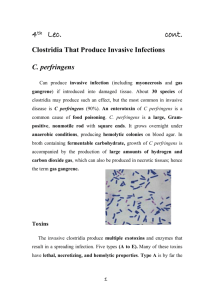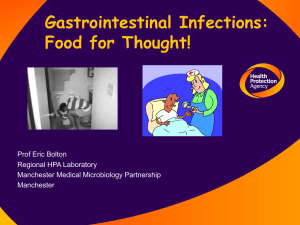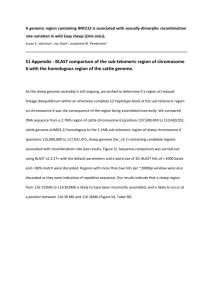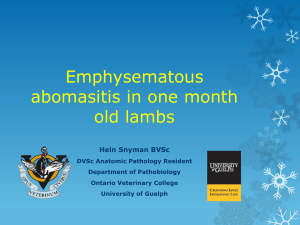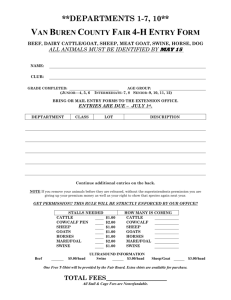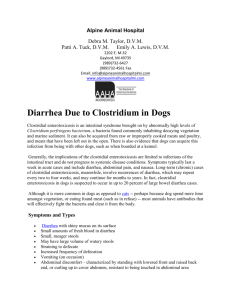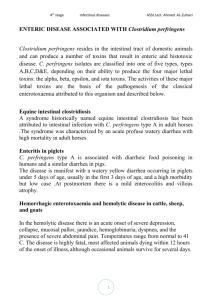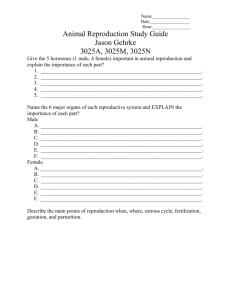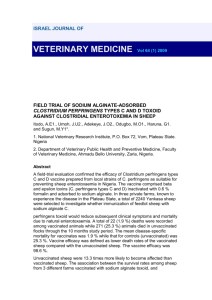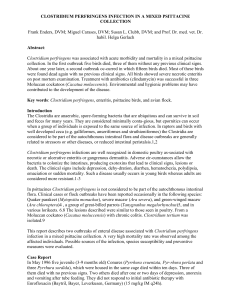CLOSTRIDIAL DIARRHOEA IN FOOD ANIMALS IN IBADAN, NIGERIA
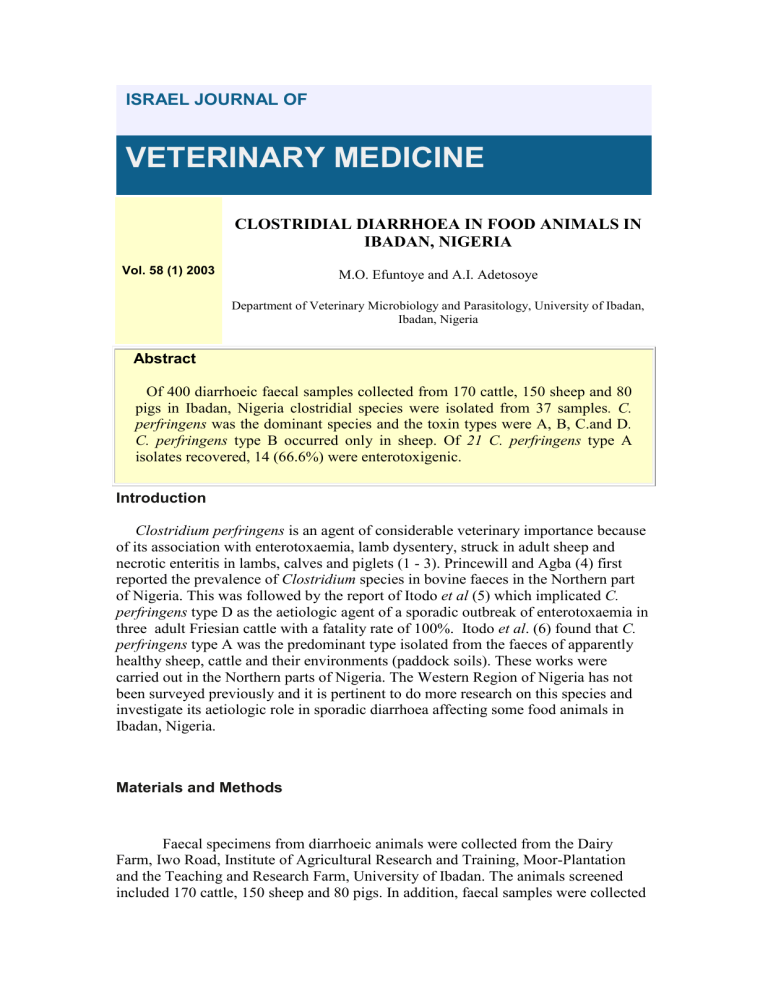
ISRAEL JOURNAL OF
VETERINARY MEDICINE
CLOSTRIDIAL DIARRHOEA IN FOOD ANIMALS IN
IBADAN, NIGERIA
Vol. 58 (1) 2003 M.O. Efuntoye and A.I. Adetosoye
Department of Veterinary Microbiology and Parasitology, University of Ibadan,
Ibadan, Nigeria
Abstract
Of 400 diarrhoeic faecal samples collected from 170 cattle, 150 sheep and 80 pigs in Ibadan, Nigeria clostridial species were isolated from 37 samples . C. perfringens was the dominant species and the toxin types were A, B, C.and D .
C. perfringens type B occurred only in sheep. Of 21 C. perfringens type A isolates recovered, 14 (66.6%) were enterotoxigenic.
Introduction
Clostridium perfringens is an agent of considerable veterinary importance because of its association with enterotoxaemia, lamb dysentery, struck in adult sheep and necrotic enteritis in lambs, calves and piglets (1 - 3). Princewill and Agba (4) first reported the prevalence of Clostridium species in bovine faeces in the Northern part of Nigeria. This was followed by the report of Itodo et al (5) which implicated C. perfringens type D as the aetiologic agent of a sporadic outbreak of enterotoxaemia in three adult Friesian cattle with a fatality rate of 100%. Itodo et al . (6) found that C. perfringens type A was the predominant type isolated from the faeces of apparently healthy sheep, cattle and their environments (paddock soils). These works were carried out in the Northern parts of Nigeria. The Western Region of Nigeria has not been surveyed previously and it is pertinent to do more research on this species and investigate its aetiologic role in sporadic diarrhoea affecting some food animals in
Ibadan, Nigeria.
Materials and Methods
Faecal specimens from diarrhoeic animals were collected from the Dairy
Farm, Iwo Road, Institute of Agricultural Research and Training, Moor-Plantation and the Teaching and Research Farm, University of Ibadan. The animals screened included 170 cattle, 150 sheep and 80 pigs. In addition, faecal samples were collected
from 40, 50 and 30 healthy cattle, sheep and pigs respectively. Samples were serially diluted and cultured aerobically and anaerobically on standard enteric isolation media and on sheep blood agar supplemented with 100µg/ml neomycin sulphate and incubated anaerobically for the isolation and identification of clostridia. The isolates were characterized by standard methods for identification of clostridia (7, 8).
Alcohol shock treatment (9) was used to quantitate the numbers of C. perfringens present in the faeces. The C. perfringens were further characterized by toxin typing and enterotoxin production. Toxin-typing was performed as described by Sterne and
Batty (10) using neutralizing antisera (Wellcome, England). Production of enterotoxin was determined with “PET-RPLA” kit (Oxoid, U.K), as recommended by the manufacturer
Results
C. perfringens was isolated in pure culture from diarrhoeic feces of 7 pigs, 16 sheep and 14 cattle. In most cases the number of colony forming units (cfu) per gram of faeces was in excess of 1.5 X 106 for diarrhoeic animals compared with cfu/g of not more than 1.62 X 102 in non-diarrhoeic samples. Neither aerobic nor any other anaerobic bacteria of pathogenic importance were isolated from samples positive for
C. perfringens.
However three genera of aerobic bacteria, Bacillus cereus , Aeromonas hydrophila and Escherichia coli were isolated differently and exclusive of other species from 24 samples in aerobic culture (Table 1). The overall frequency of isolation of C. perfringens in this study was 9.2%. C. perfringens types A, B, C and
D were encountered in sheep , C perfringens types A and C were recovered from pigs and C. perfringens types A, C and D were isolated from feces of diarrhoeic cattle
(Table 2). All the isolates recovered from non-diarrhoeic animals were C. perfringens type A (8 from cattle, 3 from sheep and 1 from pig). The number of isolates of C. perfringens type A positive for enterotoxin production are shown in Table 2. All the three isolates of C. perfringens type A from pigs produced enterotoxin while more than half of the isolates from sheep and cattle were enterotoxigenic. None of the isolates from healthy animals were enterotoxigenic.
Discussion
This study has shown that various types of C. perfringens are present, in cattle, sheep and pigs in Western Nigeria. This is thus an additional information to those of
Princewill and Agba (4), Itodo et al . (5, 6) and Okewole et al (11). In this study type
A was detected from all the feces of diarrhoeic animals positive for C. perfringens and C. perfringens type A appeared to be the dominant type in cattle. Brooks and
Entessar (12) reported the isolation of aberrant strains of C. perfringens type B affecting adult sheep and goats in the Middle East. Itodo et al.
(6) also detected type B in cattle, while type B was not recorded in cattle in this study but only from sheep.
The incidence of C. perfringens type D was higher in diarrhoeic faeces of sheep than of cattle. This agrees with reports of Cygan et al.
(13), Itodo et al.
(6) and
Youman et al (14). The only cattle where type D was found in this study and the sheep from which C. perfringens typed D was isolated were all from the same farm.
All the isolates of C. perfringens type A from pigs produced enterotoxin.
Estrada-Corea and Taylor (15) reported that some C. perfringens type A isolated from cases of diarrhoea in pigs were enterotoxin producers. The findings in this investigation were different from those of vanDamme Jongsten et al . (16) where none of the C. perfringens strains from diarrhoeic syndrome in piglets produced enterotoxin. Enterotoxin was produced by 6 out of 11 C. perfringens type A strains recovered from cattle. Although this suggests that enterotoxigenic C. perfringens type
A may play some role in bovine diarrhoea, the absence of such report in the literature called for further work to resolve its role. Most reports of enterotoxaemia in sheep are associated with C. perfringens type D and its toxins alpha and epsilon. There appeared to be no known information on the isolation of C. perfringens type A from lambs and sheep, hence no report on detection of enterotoxin. In the present investigation, five (71.4%) of the seven ovine isolates of C. perfringens type A produced enterotoxin. Further detailed assessment of its role in lamb and sheep diarrhoea is required. There are reports implicating C. perfringens type C in diarrhoea among piglets (3, 17 - 19). No such report exists in Nigeria except for Okewole et al
(11) who had reported enterotoxaemia caused by C. perfringens type A in five intensely managed piglets with 100% fatality rate. The presence of C. perfringens type C in pigs and cattle with diarrhoea calls for more research on diarrhoea involving these livestock in Nigeria.
In this study, the diarrhoeic animal had particularly high colony counts of C. perfringens type A compared with fecal samples from healthy animals. Smith (20) reported that C. perfringens type A strains are found in low numbers as part of the microflora of the intestinal tracts of healthy sheep, goats and cattle. The high carriage observed in diseased animals in this study is thus evidence for a pathogenic role for the organism. Further support is provided by the observation that all the strains of C. perfringens type A isolated from diseased animals produced enterotoxin while none from healthy animals produced toxin. Thus, a significant correlation exists between enterotoxin production and diarrhoeal disease in these animals.
LINKS TO OTHER ARTICLES IN THIS ISSUE
1.
References
1. Twedt, D.C.: Canine Clostridium perfringens diarrhoea. Proc. Ann. Waltham-OSU Symp. Treat.
Small Anim. Dis . 17: 28-32, 1993.
2. Tariel, G., Collobert, C., Letot, G., Fortier, G., Lamidey, C. and Legardinier, C.: Epidemiological post-mortem survey of equine intestinal clostridiosis in Normandy from 1987 — 1992. Pratique
Veterinaire Equine 26: 233-239, 1994.
3. Buogo, C., Capaul, S., Hani, H., Frey, J. and Nicolet, J.: Diagnosis of Clostridium perfringens type C in pigs using a DNA amplification technique (PCR). J. Vet. Med . (Series B) 42: 51-58, 1995.
4. Princewill, T.J.T. and Agba, M.I.: Examination of bovine faeces for the isolation and identification of Clostridium species . J. Appl. Bacteriol. 52: 97-102, 1982.
5. Itodo, A.E., Agba, M.I. and Okewole, P.A.: Clostridium perfringens type D enterotoxaemia in cattle. Bull. Anim. Hlth Prod. Afr . 31: 193-195, 1983.
6. Itodo, A.E., Adesiyun, A.A., Adekeye, J.D. and Umoh, J.O.: Toxin-types of Clostridium perfringens strains isolated from sheep, cattle and paddock soils in Nigeria. Vet. Microbiol . 12: 93-96, 1986.
7 Sutter, V.L., Citron, D.M. and Finegold, S.M. (eds): Wadsworth Anaerobic Bacteriology Manual,
4th edition, C.V. Mosby and Co. St. Louis, 1984.
8. Barrow, G.I. and Feltham, R.K.A. (eds): Cowan and Steel’s Manual for the identification of medical bacteria, 3rd edition, University Press, Cambridge, 1993.
9. Koransky, J.R., Allen, S.D. and Dowell, V.R.: Use of ethanol for selective isolation of spore-forming microorganisms. Appl. Environ . Microbiol. 35: 762-765, 1978.
10. Sterne, M. and Batty, I.: Criteria for diagnosing clostridial infections. In: Pathogenic clostridia,
Butterworths, London, 1975.
11. Okewole, P.A., Itodo, A.E. Oyetunde, I.L., Chima, J.C., Irokanulo, E.A. and Ocholi, R.A.:
Clostridium perfringens type A enterotoxaemia in pigs: a report of five cases. Br. Vet. J . 147: 484-485,
1991.
12. Brooks, M.E. and Entessar, F.: Anomalous Clostridium welchii type B strains isolated in Iran. Br.
Vet. J.
113: 506-508, 1957.
13. Cygan, Z., Barcz, I. and Deptula, D.: Anaerobic enterotoxaemia of sheep due to Clostridium perfringens type D. Med. Weter . 34: 31-34, 1977.
14. Youman, M., Both, H. and Muller, W.: Frequency of Clostridium perfringens types in Jordanian sheep. Int. J. Med. Microbiol. Virol. Parasitol. Infect. Dis . 281: 240-247, 1994.
15. Estrada-correa, A.E. and Taylor, D.J.: Porcine Clostridium perfringens type A spores, enterotoxin and antibody to enterotoxin. Vet. Rec . 124: 606-610, 1989.
16. Van Damme-Jongsten, M., Haagsma, J. and Notermans, S.: Testing strains of Clostridium perfringens type A isolated from diarrhoeic piglets for the presence of enterotoxin gene. Vet. Rec . 126:
191-192, 1990.
17. Horugel, K. and Zabke, J.: Clinical aspects and treatment of early diarrhoea in unweaned piglets.
Monatshefle-fur-Veterinarmed 440: 155-159, 1984.
18. Ohnuna, Y., Kondo, H. Saino, H., taguchi, M., Ohno, A. and Matsuda, T.: Necrotic enteritis due to
Clostridium perfringens in newborn piglets. J. Jpn. Vet. Med. Assoc . 45: 738-741, 1992.
19. Okazaki, Y., Inage, M., Iwabuchi, I., Suzuki, T., Okada, N., Watanabe, K. and Yamamoto, T.:
Mass outbreak of necrotic enteritis in newborn piglets caused by Clostridium perfringens type C on a pig farm. J. Jpn. Vet. Med. Assoc . 46: 214-217, 1993.
20. Smith, H.W.: Observations on the flora of the alimentary tract of animals and factors affecting its composition. J. Pathol. Bacteriol. 89: 95-122, 1965.
